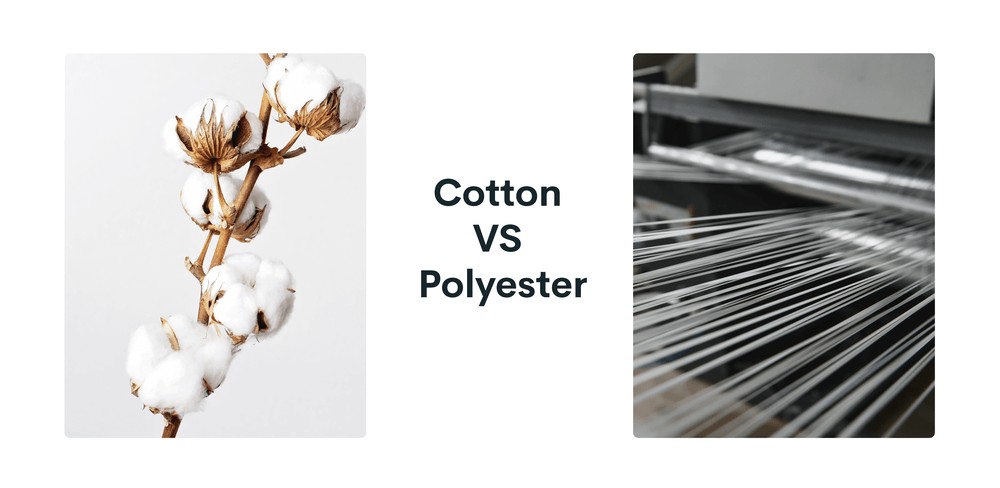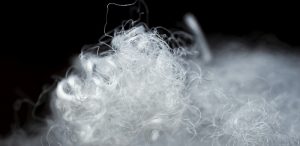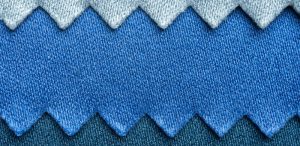Whether you’re just starting out or have been in the print-on-demand business for a while, learning or refreshing your knowledge of cotton and polyester fabrics never hurts.
Fabric choices matter. The composition of the garment is arguably the most important factor when it comes to selling apparel. Each fabric has different properties. The garment might look absolutely amazing, but if the fabric is low quality, wears out easily, or shrinks excessively, it won’t appeal to your customers.
After reading this article, you’ll have a better understanding of different types of fabrics, their characteristics and functionality. We will lightly touch on how cotton and polyester are made and see why sometimes blended fabrics are the way to go.
This knowledge will help you choose the most appropriate fabric for your brand and make the best use of it.
- What Is a Fiber?
- What Is a Fabric?
- Cotton vs. Polyester
- What Are the Characteristics of Polyester Fabric?
- The Many Uses of Polyester
- What Are the Characteristics of Cotton?
- Four Different Types of Cotton
- The Many Uses of Cotton
- What Are Blended Fabrics?
What Is Fibre?

In the textile industry, fiber, or fibre, is a material mainly made from natural or synthetic sources. The raw materials are turned into fiber, but fiber itself is spun into yarns, which then are woven or knit to make fabrics.
All fibers are classified by their chemical origin into two groups.
- Natural Fibers. They’re made out of natural materials that come from plants (cotton, flax, linen, etc.), animals (wool, silk, mohair, etc.), or minerals. Mineral fibers, however, are not commonly used in textile manufacturing.
- Synthetic Fibers. These are made by humans through chemical processes. Some examples of these fibers are polyester and its synthetic siblings – nylon, acrylic, spandex, etc.
What Is Fabric?
As stated previously, fibers are the cornerstone of all clothing. Then comes the yarn. A yarn is a continuous length of interlocked fibers. It is used for the production of woven and knitted fabrics or thread for sewing, embroidery, and crocheting. In short, fabric is the raw material from which clothes and other items are made.
Although there are many, the two main processes of making fabric from yarn are:
- Weaving. Interlacing two sets of yarns so that they cross each other, usually at right angles.
- Knitting. Knitted fabrics are made by interlocking a series of loops made from one or more yarns. Knitted fabrics are manufactured on highly sophisticated industrial knitting machines.
The process of turning fibers into fabric is much more complicated than it seems – we tend to underestimate the amount of work that goes into creating the clothes that we wear, the blankets we tuck ourselves into, and the socks we randomly throw in the drawer.
Cotton vs. Polyester


Although cotton is the most widely used natural fiber, polyester is the most popular synthetic fabric in the world. They are both go-to fabrics for clothing, accessories, and home décor. Each has its own distinct qualities and uses.
What is the main difference between cotton and polyester? In short, the difference lies in how they are made and what their characteristics are. Polyester vs. cotton – which is better? It all depends on your needs and what kind of product you want to make.
Read on as we dig deeper to learn more about their particular benefits and disadvantages.
What Are the Characteristics of Polyester Fabric?
As with every fabric, polyester has its own unique characteristics that determine its best use. It is a perfect fabric for outdoor and sports clothing – a strong fiber that holds its shape well and can withstand creasing, stretching, shrinkage, and repetitive movements.
- Lightweight. Polyester fabric is well suited for a wide variety of sports. Excellent for activewear clothing and demanding outdoor activities.
- Extremely Durable. Due to polyester’s incredibly strong fibers, it’s known as the workhorse of fitness fabrics.
- Moisture-Wicking. This material is naturally water-resistant, but not waterproof. The polyester fabric will wick moisture away.
- Easy to Care For. Polyester fibers do not wrinkle, and dry quickly. If it’s left outside in direct sunlight and open air, it can dry in an hour or less.
Let’s look at some of its negatives.
- Feels Coarse. There are different types of polyester. Some polyester fibers feel coarse, rough, and even slippery against your skin, but others, like China silk, are almost as smooth as satin.
- Typically Non-biodegradable. Though polyesters and other synthetic fabrics will eventually break down, it might take from 20 to 200 years.
- Melts Under Heat. While some polyester fabrics have a high burning point, it melts more easily than you think. It should not be worn while working in the kitchen or near an open flame.
- Mostly Non-breathable. Garments made out of polyester are not naturally breathable, but some polyester fabrics are manufactured specifically to provide breathability.
It is important to note that not all polyester is created equal. There are a variety of fabrics made from polyester. Many of them are trademarked, and some are very popular, such as Capilene, Polartec, Primaloft, Thermolite, or Trevira.
The Many Uses of Polyester


Polyester fabric is prized for its relative affordability, strength, and wrinkle resistance. Although it’s water-resistant, it’s not completely waterproof until it has been treated with water repellent or coated with a layer of extra fabric.
These, and other polyester characteristics previously mentioned, are why this synthetic fabric is the most popular fiber for clothing. However, polyester fabric is also used to make many different products.
Due to polyester’s highly functional fiber, it’s well suited for making a vast array of garments.
Most common uses:
- Fashion and high-end fashion products
- Sportswear, activewear, footwear
- Jackets, coats, anoraks
- Fleece, sheets, duvet covers, sleeping bags
- Military clothing
- Soft furniture and upholstery, luggage and other bags, rugs, carpets, etc.
Additionally, there are also industrial polyester fibers that are used to make things like seat belts, conveyor belt fabrics, plastic reinforcements, and many other items.
Polyester fabric has an immense variety of practical uses in many different sectors. Today, technological advances keep improving the feel, drape, and look of polyester.
Some of our customizable items that are made from polyester:
Whatever your goals, our mission stays the same – to help people make more money with less effort. With Printify, you can start your own business without any up-front costs. What’s more, our powerful Mockup Generator allows you to easily create real products. Afterwards, we take care of everything – printing, inventory, and shipping.
The best part is that registering is completely free, and you can order as few or as many items as you like.
Make Your Own Custom Products Today!
What Are the Characteristics of Cotton?


Cotton is a luxuriously comfortable material that has a charm of its own. One of the softest fabrics on earth, cotton is well suited for clothing and other items we use in our daily lives.
- Comfortable. Fabric made out of cotton is very soft and comfortable. It is one of the best fabrics for hot weather. It stays cool in summer and allows you to keep your zen throughout the day.
- Durable. Although it’s not as tough as polyester, cotton is a relatively strong and wear-and-tear resistant fabric.
- Biodegradable. This material is renewable and biodegradable. However, it is extremely water-intensive and consumes more pesticides than any other single crop.
- Breathable. Due to its breathability, absorbency, and hypoallergenic nature, cotton is often used for underwear, socks, and other garments that are worn close to the skin.
Some of its negatives:
- Low Resilience. Some products made from cotton crease badly and may not recover well. It also shrinks after washing and stains easily.
- Flammable. Cotton catches fire easily and burns rapidly.
- Susceptible to Mildew. Mildew causes rotting and degradation. Although anti-mildew finishes can be applied, if you are going to use this fabric in a humid environment, then it's not the best choice.
- Absorbs a Lot of Moisture. This can be both a positive and negative quality, depending on the circumstances. It is great in summer, but may be dangerous in windy and cold conditions – it dries slowly, so you stay wet and cold, which can lead to hypothermia.
As with polyester, not all cotton is made equal – physical properties differ.
Four Different Types of Cotton


As one of the most popular natural fibers, cotton is grown commercially all around the world. Due to its excellent qualities, it has been used since ancient times to create a variety of products.
These are the most common:
Pima Cotton
This is considered to be the finest cotton in the world. It has extra-long fibers, which makes luxuriously smooth, soft, and strong fabric that is resistant to tearing, wrinkling, and fading.
Egyptian Cotton
Similar to Pima cotton, they both share premium characteristics – extra-long fibers that make it soft, smooth, and durable. The difference lies in where they are grown. Pima cotton is primarily grown in the United States, Egyptian cotton in the Nile River Valley.
Upland Cotton
The most widely cultivated cotton species in the world, making up 90% of worldwide production. Although it’s not as soft as Pima or Egyptian, it’s an excellent fiber for everyday products. It is an affordable option.
Acala Cotton
A special variety of cotton produced only in California, in the ideal climate of the San Joaquin Valley. One of the highest-quality Upland cottons in the world. Unfortunately, it tends to be more expensive, due to its growing requirements.
The Many Uses of Cotton
The world’s favorite natural fiber has a wide range of applications. Due to its versatility, beauty and comfort, cotton is an ideal choice for apparel, bedding, textiles, and many other products. Whether we know it or not, it’s part of our daily lives.
Common uses:
- Clothing. Cotton is a popular fabric that is used to make various clothing. It is frequently used for t-shirts, jeans, sweatshirts, dresses, and many other items.
- Woven Fabrics. This material is used to make a variety of woven fabrics – denim, damask, flannel, and more.
- Bed Sheets and Bedding. Perfect for the bedroom. Cotton is an affordable luxury – breathable, soft, and easy to care for.
- Towels and Washcloths. Cotton is highly absorbent, which makes it ideal for towels.
- Underwear. Since cotton is breathable and provides greater airflow, it’s a comfy choice for undergarments.
- Home Décor. Attractive throughout the home. Well suited for curtains, carpets, rugs, upholstery, and much more.
- Cottonseed Oil. Cottonseed is a byproduct of the cotton production process. The seeds are used to manufacture cottonseed oil, which can be used to make salad oil. It can also be used in soap, candles, cosmetics, and more.
These are just a few things that you can make with cotton. It can also be used to make tote bags, shoelaces, paper, and many other practical products. In short, cotton has almost limitless potential.
Take a look at some of our customizable items that are made from cotton:
Create Your Own Merchandise & Start Selling Today!
What Are Blended Fabrics?


If polyester and cotton are blended together, you get poly cotton. By blending, it’s possible to produce fabrics that exhibit properties unachievable with either fiber alone.
With these blends, manufacturers are able to make clothing that’s stronger, more customizable, and more versatile than pure cotton. Poly cotton combines the best of both worlds – the moisture-wicking ability of polyester with the breathability of cotton.
If you can’t choose between cotton or polyester, let’s look at their blends and see whether one of these would better fit your brand and needs.
50% Cotton / 50% Polyester Blend
A popular blend for casual and commercial clothing. It is often used in commercial and athletic uniforms. However, it’s well suited for everything from t-shirts to hoodies to bedding. The garments are more breathable than 100% polyester products.
65% Cotton / 35% Polyester Blend
A good choice for casual wear – it is less likely to shrink than pure cotton. A common ratio that is popular for making workwear, because of its price and tear resistance.
65% Polyester / 35% Cotton Blend
This is a typical blend. It is good for athletic wear. This blend also works well for making shirts, uniforms, bedsheets, and more. It is easy to take care of.
These days, a split between these two fabrics is a common sight. They’re popular because they provide a healthy balance between breathability, durability, comfort, and price.
Take a look at some of our customizable items that are made from blended fabrics:
Frequently Asked Questions
Does Polyester Stretch?
It depends. Today, there are different types of polyesters and each has its own unique characteristics – some stretch, some do not. However, polyester fibers themselves do not stretch, which means that the garment does not lose its original size or shape.
How to Shrink Polyester?
Although polyester isn’t prone to shrinking, it’s possible to make the garment smaller. It all depends on the type of fabric you are working with. Polyester is heat-intolerant, so you can use either a washing machine or a dryer to achieve the desired result. Keep in mind that polyester blends shrink more easily than 100% polyester fabric.
Where Is Cotton Fabric Produced?
Cotton is a versatile material that is widely produced all over the world. The leading cotton producers are China, India, the United States, Brazil, Pakistan, Uzbekistan, and Turkey. It is one of the most popular textiles in the clothing manufacturing industry.
How to Wash Polyester?
Always check the fabric’s care label first, because polyester is generally combined with other fabrics. Polyesters can be machine washed on the cold setting. However, warm water is also okay, but make sure to separate colors and avoid including anything with deep or intense dyes.
Is Polyester Waterproof?
As a fabric, polyester is not waterproof. The threads themselves won’t absorb water as cotton does, but water will pass through the gaps between the threads. Polyester has water-resistant properties, but it’s not completely waterproof unless it’s coated with special materials.
The Key Takeaways
In the world of fiber, neither is better. The truth is – they both have their advantages and drawbacks. Neither of them will ever replace the other. On the contrary, by blending these fabrics together, they complement each other in many wonderful ways.
It is all about being savvy when it comes to picking your fabric – the more you know, the better choices you can make. If you do your research, there’s no reason why you, cotton, polyester, and their blends can’t all be friends.
Start Your Own Print-On-Demand Business Today
The post Guide to Polyester, Cotton, and Blended Fabrics appeared first on Printify.



 Hooded Sweatshirt
Hooded Sweatshirt 



